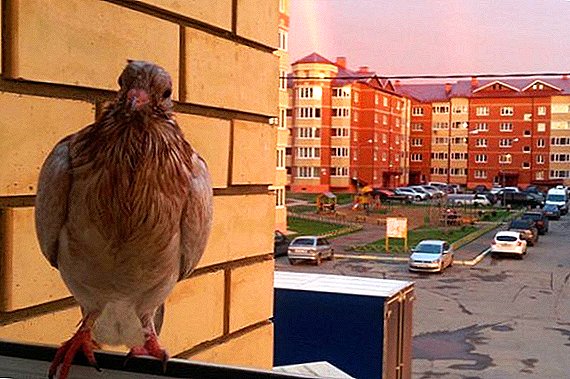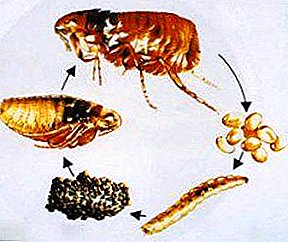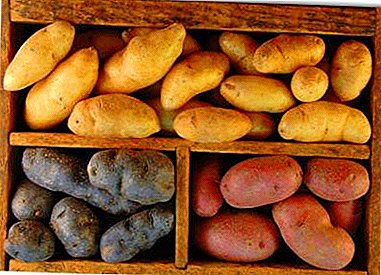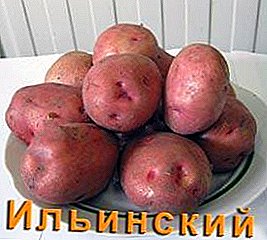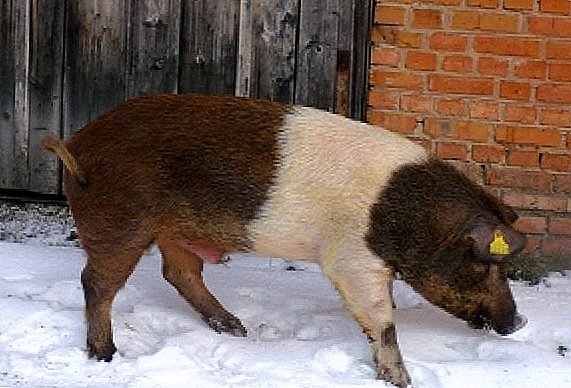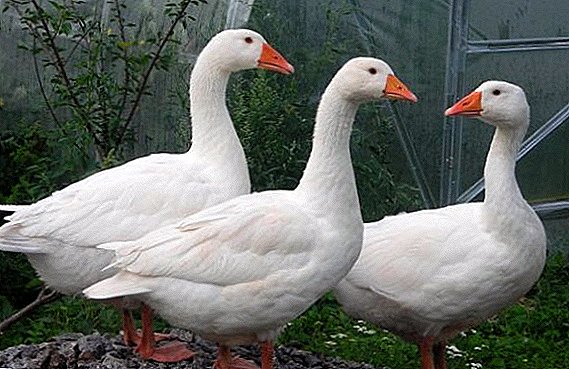 Danish legart is not yet known to all the poultry farmers in our latitudes, but this is only a matter of time. After all, these geese have excellent performance, excellent fluff, tasty meat and docile nature. From an economic point of view, breeding a breed is very profitable, so in this article we will talk more about their merits, growing conditions and reveal the secrets of successful breeding.
Danish legart is not yet known to all the poultry farmers in our latitudes, but this is only a matter of time. After all, these geese have excellent performance, excellent fluff, tasty meat and docile nature. From an economic point of view, breeding a breed is very profitable, so in this article we will talk more about their merits, growing conditions and reveal the secrets of successful breeding.
Description and Features
Among the advantages of the Danish Legart note:
- active growth and rapid weight gain;
- a small proportion of deaths of both goslings and adults;
- high egg fertility.
Did you know? Loyalty is not only characteristic of swans. Their closest relatives, geese, also choose a mate for life. It happens at the age of 3-4 years. If the partner dies, the survivor is sad for several years.
Origin
Legarty are not for nothing called the Danish breed. These geese were bred in Denmark on the basis of several species in order to create a large bird that will differ in fecundity without requiring any special maintenance costs. A number of years were spent on the removal of the Danish Legart, but the result achieved was worth it. In recent years, the species was introduced to the CIS, where it is spreading rapidly. 
Appearance
It is easy to distinguish Danish legart from domestic geese:
- they are larger: the weight of the gander reaches 8 kg, and the geese - 5-7 kg;
- they have a different form of the body: in males it resembles a square, whereas in females it is slightly elongated;
- Purebred legart has a beautiful, swan neck, which is finally formed by the fifth month of life;
- their beaks and paws differ in red-orange tint;
- a light white spot in the form of a drop is visible on the tip of the beak;
- on the stomach stands out a small fold of fat;
- Legartes are also distinguished by beautiful blue eyes;
- after molting they have a white fluff, thanks to which they look favorably in comparison with other neighbors in the farmstead.
By the way, their gait is also remarkable: slow, graceful, on bent paws, not similar to traditional goose walking.
Among the many bird species for hunters and ornithologists, wild geese are of great interest: the white goose, the black goose (brant), the white-fronted goose.
Character
The Danish breed has a meek temper and silence. Legarts rarely fight, easily manageable and obedient. For this they are very fond of the owners, because such pets do not cause unnecessary trouble. 
Maturation rate
On puberty legart it takes 250 days for geese and 270 males. At the same time, this period is much less for late broods. Birds start laying in early April.
Annual egg production
On average, legart breed geese give 25 to 40 eggs, out of 65% of which chicks appear.
Find out when geese start to fly at home, as well as what are useful and how goose eggs are used.
Meat quality
The carcass of a representative of this species weighs from 4 to 6 kg. Goose meat is usually considered fat, but legarts are an exception to the rule. Their diet fillet has a delicate flavor, and this is an indicator of high quality.
The list of its advantages include:
- a large amount of vitamins of group B, A, PP, C;
- minerals;
- fat, which is collected in the skin, so that the meat retains its dietary properties.

Conditions of detention
Geese are undemanding in maintenance, they don’t need much for comfort: just a warm room for cold weather and a comfortable, spacious patio for summer walks.
Did you know? Geese are long-lived, some of them are able to live up to 25 years.
Requirements for the room
It is important to protect Legartes from wind, temperature fluctuations, and frost, so they should have their own goose.
In its construction and arrangement, consider the following:
- There are no special material requirements for construction, but it is better to finish the walls with chipboard, plywood or plaster from the inside. This is necessary to warm the room and facilitate its cleaning.
- If possible, make windows and doors on the south side. Allocate at least 10-15% of the total area for them: the light has a positive effect on the health and laying of eggs. During this period, geese need about 14 hours of daylight, otherwise they rush badly and lose weight.
- The size of the goose goose depends on the number of individuals in the flock: at least 1 square meter is needed for 1 goose. m
 Inside the premises for the convenience of birds put:
Inside the premises for the convenience of birds put:- nests at the rate of one to two geese. It is better to equip them in the southern part of the goose, in a slightly darkened place;
- at least 3 feeders: for wet, dry feed and mineral additives;
- drinkers: for a dozen individuals enough 1 pc. 2 m long;
- a litter of peat, sand, sawdust or straw 5-8 cm thick: if it is less, then the layer will not be enough, and at a level above 12 cm it is difficult to change it.
Did you know? Little geese are able to swim already on the second day after birth.
Courtyard for walking
Walking in the fresh air is useful for Danish legartes, so in summer they need a spacious courtyard where they will walk for pleasure. In a secluded place make them a canopy to hide from the heat and the sun in the heat. Not hurt and a small pond. However, if this is not possible, then try to regularly bring them to pasture or meadows for grazing for the whole day. This will have a positive effect on their health and productivity. 
What should I take care of in winter
Winter is a difficult period for these birds in need of movement and large amounts of greenery. Therefore, it is necessary to provide them with a comfortable dwelling in the goose. To do this, monitor the condition of the drinkers: they should always be water, but it is important that it does not spill out.
An important point is the correct indoor climate: the temperature is about + 22 ... +30 ° С, otherwise the birds will suffer from overcooling or overheating. In too hot environments, the number of eggs decreases and the weight decreases in geese. There are recommendations on humidity: it should be at the level of 60%. To do this, it will be necessary to equip the goose with ridge ventilation, which will remove excess heat.
Important! This is necessary because low humidity is dangerous for Danish legarts - with an indicator below 50%, their mucous membranes become inflamed and their feathers break. And an excess of moisture in the room can provoke the growth of fungi and diseases.
What to feed
Nutrition - an important factor for productivity and weight gain geese. This item must be monitored, starting with the birth of the chicks. After all, kids need special attention, because they lay the potential of a future bird.
Goslings
Feed the goslings start from the first day, as soon as their fluff dries. Food in this case is needed not so much for nutrition as for the removal of yolk residues from small organisms. Due to this, babies become stronger, they have a greater chance to survive.  Newborn give:
Newborn give:
- eggs, previously boiled and finely crumbled;
- ground grain;
- corn grits, ground with greens.
Even at such a tiny age, the chick menu is 50% grass. Feeding is carried out on average every 3-4 hours, up to 8 times per day, while babies should always have fresh boiled water. But dairy products while banned.
WITH first week The goslings feed no more than 6 times a day, and their menu tolerates some changes:
- there are no eggs in it;
- protein feeds appear;
- time to increase portions (up to 30% compared with the first day);
- minced peas minced to increase protein levels;
- Additionally, you can enter bone meal, fish oil, animal feed as vitamins.
 To end first month already give lives to the goslings:
To end first month already give lives to the goslings:
- peas with greens and selected grain as a base;
- wet and dry mixes for variety;
- boiled beets, carrots, potatoes;
- You can add a little fresh cottage cheese.
Important! Food at the same time should remain crumbly. Adhesive food often provokes the clogging of the nasal passages in babies.
Wet food should be given fresh, within half an hour after preparation, twice a day. Heavy food in the diet of monthly goslings should be no more than a quarter. They eat 3 times a day mostly, but feed a little at night.
Starting from second month of life, the young growth eats already with adults.
In addition to the above components of the diet, it's time to add:
- cake;
- small shell;
- crumbled chalk;
- bran.
Read also about the pros and cons of keeping at home geese breed large gray, Linda.
Adults
Danish legart is a very economical breed: on average, these geese eat 20% less than representatives of other species.  The diet of these birds depends on the season. In the summer they eat up to 2 kg of fresh grass per day, which is enough for them. Only in the evening you can pour a little grain in the feeders.
The diet of these birds depends on the season. In the summer they eat up to 2 kg of fresh grass per day, which is enough for them. Only in the evening you can pour a little grain in the feeders.
But in winter the situation is much more complicated. So that the birds do not lose weight and feel well, since summer, prepare:
- wheat grass, alfalfa, clover hay (on average 15 kg per 1 animal for the whole season);
- vegetables: carrots, beets, Jerusalem artichoke.
Important! The latter is especially important in the menu of birds: thanks to the earthen pear, the likelihood of illness in geese is reduced, food is better absorbed, which contributes to weight gain. Therefore, it is impossible to limit its reception.
In winter, the level of combined feed increases by 30-40%, and add them to each of the three meals. The average amount of dry stocks per season is 37 kg per individual. Birds will also be grateful for supplements in the form of:
- rose hips;
- hawthorn;
- viburnum;
- algae;
- birch leaves;
- oak acorns;
- earthworms, which need to dig in the summer, and then can be stored in boxes with earth in the basement.

Breeding chicks
It is profitable to engage in breeding Danish legarts:
- they are unpretentious;
- have a good survival rate;
- grow rapidly;
- Excellent weight gain.
Hatching period
During the season, one goose is able to carry up to 40 eggs, but the instinct of hatching is not on the list of the strengths of this breed. Therefore, if you want to engage in breeding legart, take care of the incubator.
When in rare cases, the female still displays maternal inclinations, then she cannot do without a special spot. Equip her nest in the shade, in silence. Next put the feeder with a drinker. The temperature in the room is about +12 ° С. An average of 10-13 eggs are laid under one goose.
Important! If the place of laying is too light, the bird will begin to show aggression, pull out the fluff on the chest and may later abandon the offspring.
On average, the appearance of goslings takes about 28 days. If it is difficult for one of the babies to be born, then he should be helped a little bit without damaging the shell. The female walks and feeds its goslings independently.  If you have to resort to the incubator, then remember a few rules:
If you have to resort to the incubator, then remember a few rules:
- pick up clean oval eggs;
- check them for light: there should be a black spot of yolk visible, which is evenly distributed in the shell;
- in good eggs there will be no blotches in the protein area.
The first 6 days in the incubator require a temperature not lower than +38 ° C, then the degree should be gradually lowered to +22 ° C. Turn the eggs every 3-4 hours, and every few days check them with an ovoscope to remove dead embryos.
Read also about the selection criteria and characteristics of the best incubators: "Cinderella", "Blitz", "Perfect hen", "Layer".
Pay attention to the humidity in the device: after the birth of babies, it will be about 70%, after which it can be lowered to 46%. 
Care for the young
For babies, prepare a clean room - they can easily pick up diseases in unsanitary conditions. Regularly clean them troughs and drinkers, change the feed for fresh - for goslings problems with the gastrointestinal tract.
Did you know? Wild geese during interseasonal flights can rise to an altitude of 10 km. At this level, a person can no longer breathe without an oxygen mask and loses consciousness from pressure.
To strengthen the immune system, babies need to be vaccinated. But if there are weak specimens among the chicks, they will not be disturbed by nutritious top dressing: dilute 1 yolk with 0.5 cups of milk, add "Biomitsin" or "Penicillin", which will improve immunity. Giving it is worth it with every meal. Weakened kids should not walk under the hot sun for more than 10 minutes. With the proper healthy development of goslings, in 2 months they reach a weight of 5.5-6.3 kg.
Video: Danish Legart breed
Poultry farmers reviews about the breed Danish legart


Danish legart is an excellent breed with excellent down and tasty meat. Its cultivation will not take much time and will not be difficult if you follow the recommendations correctly. Experienced poultry farmers love this breed for a good result at a lower cost than in the case of other types of geese.


